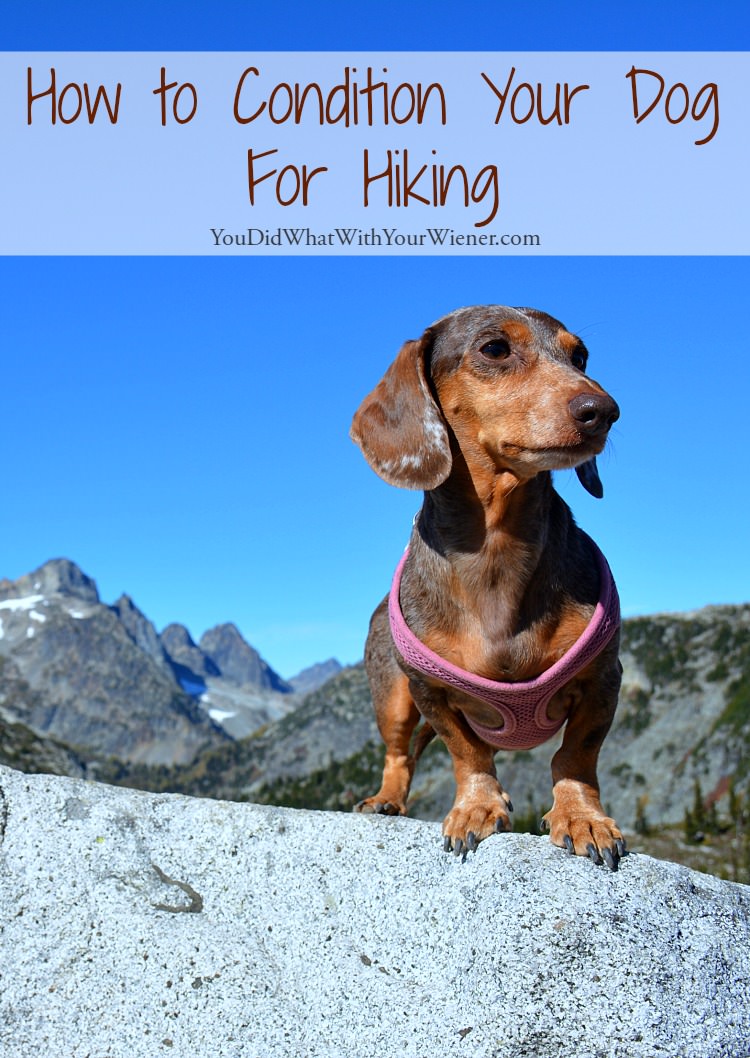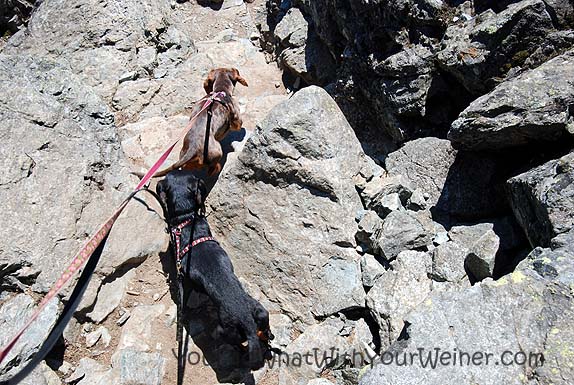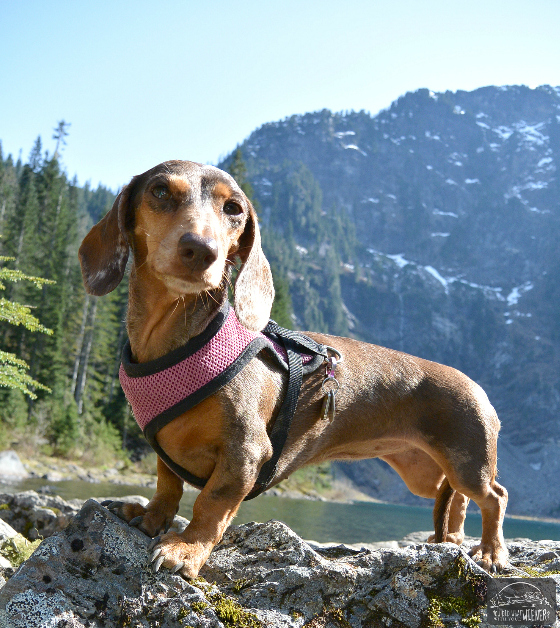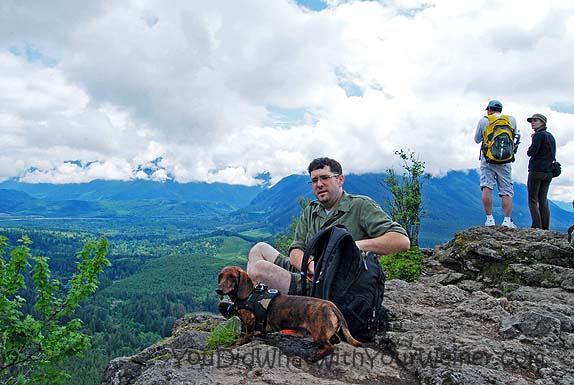Training Your Dog to Hike: Start Small Then Go Big
You have heard us go on and on about how ingrained the stereotype of small dogs is – of how they are often underestimated and are capable of so much more.
We even wrote a guest post about it over at Will My Dog Hate Me? and I compiled a list of the 10 most common comments we hear on the trail (implying they very surprised to see small dogs out hiking).
UPDATED: December 10, 2022
On our blog, we share our stories and talk about the miles we have hiked up steep mountains, over the rocks, and through the snow. We wish to inspire others to do the same.
I don’t want you to get the wrong impression though – we don’t believe that a sedentary dog should get off the couch and go conquer the highest peak in your area tomorrow (unless you can drive to the top. Ha, ha).
Dogs are just like people, they need to build up strength and stamina first to help prevent injury.

Gretel is 7 and her most difficult hike was 10 miles a day, three days in a row.
It’s not safe for a dog to do that though if they aren’t used to hiking.
I started with shorter, easier hikes when I first took Chester and Gretel hiking (respectively, they learned to hike at different times).
When it was obvious they handled those hikes no problem and wanted more, I let them take on bigger and bigger challenges.
This is how I trained them to hike.
How to Condition Your Dog For Hiking
Note: I’m not a veterinarian, a dog or people physical trainer, or a dog conditioning expert. However, from my experiences training for my own marathon and hiking with small dogs for over 10 years, I get the concept of conditioning and building physical endurance. I’m sharing what I know, and has worked for us, here. Also, ALWAYS CHECK WITH YOUR VET BEFORE STARTING YOUR DOG ON A NEW EXERCISE ROUTINE.
The first thing I did was make sure that my dogs were walking regularly.
I was walking around the neighborhood 3-5 times a week. The majority of those walks were for 45 minutes or more.
I’m not talking a “sniff walk” either. We were on a mission. I didn’t let them stop for breaks (they tried at first but soon caught on that I expected them to keep going) and we walked briskly.
Walking in itself is a great workout. You can calculate how many calories you burn walking your dog HERE.
Once they were used to walking regularly, we progressed to hiking.
Chester’s first hike was pretty flat and not very long (I started Gretel with something harder because I could see she was very athletic) to see how he liked it.
He wasn’t too tired when we finished so we walked on similar terrain but further the next time. After that, we progressed to longer and steeper hikes.

This is how I suggest working your dog up to longer hikes (and keeping them in hiking shape):
Step 1
Walk your dog around the neighborhood, or on urban paths, on pretty flat terrain at a brisk pace (a pace of around 15 minutes per mile, or four miles per hour).
Work up to 45 minutes for a minimum of 3 times a week.
Step 2
Once you know your dog can handle that, start taking them for shorter walks (about 30 minutes at first) but incorporate hills.
You can progress to walks that are a little longer and/or have more hills.
Note: you will want to continue these walks at least 3 days a week even once you start hiking to avoid “weekend warrior” syndrome, which can potentially lead to injury.
Step 3
When you are ready to start hiking with your dog, choose a trail that is relatively flat without obstacles (think a nice wooded path).
Since your dog is used to walking around the neighborhood, they will likely be able to hike 1-2 miles easily.
Remember, that distance is round trip so you’ll want to turn around at some point – definitely before they seem like they are getting tired.
Step 4
If they do ok on that, you can start increasing the length and steepness of your hikes.
It’s best to only increase one thing at a time – longer with same steepness one time and same length but steeper the time after that.
Watch your dog carefully to see when they start to get tired.
The goal is to finish the hike like they had a good workout but not to tire them out so much that they collapse and sleep for 2 whole days afterward.
Step 5
The sky is the limit from here on out. Kind of.
Each dog is an individual and their endurance and stamina depends on a lot of things like how much they like hiking, their breed, their temperament, their age, how often you hike, weather conditions, terrain, etc.
The key is to know the signs that YOUR dog has been pushed too far and stop when they get there (ideally, you would stop before they get to this point).

Some dogs won’t ever hike more than 5 miles.
I also know of a few dogs – even small dogs – that can do 18 miles in a day no problem.
My own personal limit is 10-15 miles a day (at 15, I’m pretty exhausted) so Chester and Gretel probably will never attempt hiking longer than that.
Chester did hike 15 miles with me once and it was clear that was too much for him.
Gretel has hiked 14 miles in a day. She neared that “too tired” point so I’m not sure I would ever try to push her past that distance.
How to Prevent Injury and Keep Your Dog On the Trail
Just because your dog CAN hike, doesn’t mean they are good to go anywhere, any time.
I admit that we tend toward being the “weekend warrior” and I can assure you that is NOT a good idea.
Like with people, doing nothing during the week and then being really active on the weekends can cause injury (to the humans involved too).
Consistently is something I’m always trying to work on.
There are some things you should do to help ensure your dog stays injury free:
Keep Your Dog Active In Betwen Hikes
Like I said above, maintain a normal walking routine at home. Be sure to keep walking your dog 3-5 days a week even if they have “progressed” to hiking.
It’s important to maintain their cardiovascular fitness and walking regularly keeps their supportive muscles flexible and strong.
Consider Canine Stretching and Massage
Like with people, its ideal to stretch your dog a little after each hike.
Check out these 4 Simple, Gentle Stretches For Your Dog You Can Complete in Minutes a Day.
Doga (yoga with your dog) is also a fun way for both of you to stretch.
Massage in conjunction with stretching is also helpful.
Consider Strength Training
Have your dog do some conditioning and strengthening exercises at least once a week to help build and maintain muscle.
Honestly, this is not something I thought of until Gretel hurt her back.
I admit it’s a struggle to fit this into my already busy routine but I know it’s important because I saw a big difference in Gretel’s strength and form when we were doing them (I’m aiming to get back to her doing a couple of these things once a week, minimum).
Don’t Forget to Rest and Recover
Remember that everyone needs a rest day. Even if your dog is a super athlete, they will need some down-time to recover.
After exercise, hydration, nutrition, and relaxation are important.

With a little preparation, adventure and fun in the mountains for you and your small dog is within reach.
Be safe and have fun out there!

About the Author
Hi, I’m Jessica. I’ve been studying the Dachshund breed since 2007, owned 3 of my own, and shared in the lives of thousands of others through their owner’s stories. When I’m not sharing what I know on this blog, you can find me hiking, camping, and traveling with my adventurous wiener dogs.

Smart advice! You and your weiners are an inspiration but it’s even more important to know that you didn’t just go from 0 to 60 with them. I occasionally walk with someone who thinks our dog walks are exercise for humans, and tries to get me to push Frankie beyond his limits. I have to explain that it’s his walk as much as — really more than — mine. And if he wants to go back, then I do too!
Great point. It is easy to set your sights on a human hiking goal and bring your dog along. Even if they CAN finish it, sometimes they SHOULDN’T. It is important not to push your dog too far too soon or they can get injured or develop problems later. You not only have to be aware of your limits but you have to be a spokesperson for your dog and know their limits too.
This is great info! I wish I could hike more, but sadly we live in Florida. Can you tell me about any other things we could do?
Dachshund Nola
Don’t worry Nola – I am sure you have plenty of fun things to do…even in a flat, hot state like Florida. Ha, ha. All trails don’t have to go straight up to qualiy as hiking 🙂 Are there not any trails around where you live? I don’t know if you live inland but swimming with your Mommy and Daddy in the ocean (if you have a life jacket and stay close to shore) is great excercise. I know that I see great athletic ablility in Gretel and if given the chance she would probably excel at agility. If you don’t have any agility classes by you, maybe your Mom or Dad can make a few things for you to use and put them in the back yard or in a spare bedroom. Even chasing a ball at the park or in your livingroom gives you the chance to run off a lot of energy. Small dogs need excercise but the nice thing is that in most cases they can get by on less than a big dog. I’ll let you know if I think of anything else. Where in FL do you live?
Great advice! I have yet to be told by my dog that she’s had enough exercise for one day, but that’s because I would crash out long before she would. Not everyone has a hyperactive tornado for a companion, though, so it’s very important to know the signs of physical stress.
I admit to being one of the people who under-estimate small dogs. But lately I have wondered if one of the reasons my neighbour’s yorkie barks 24/7 isn’t just because he likes to yap. Maybe it’s because the never take him out for walk. He may be teeny, but I am sure he has energy to burn like the rest of us. Perhaps I should offer to take him with Shiva and I once in a while. Now THAT would be interesting!
I am no dog behavior expert but I do know a thing or two about dogs. I think in most cases you describe, you are pretty accurate in your assessment. Little dogs have excercise needs too and many of them don’t get it. This can lead to behavior issues that people typically associate with being a small dog – like yappy-ness or leash agression. They have so much pent up energy and they don’t have a constructive outlet for it 🙁
Chessies will rarely tell you they have had enough. We do have to stop them occasionally while hunting, especially if it is hot. They would work until they dropped. 🙂
But it is true that you have to work up their stamina through training just like people. During the winter months it is harder to train due to snow and ice and we need a period of conditioning each Spring to get them back into field condition.
It is great that you recognize their limits. People with working dogs are usually more in tune to things like that than your average dog owner. We don’t hunt but we think “wuper hiker” counts as “working dog” 🙂 You guys are proof that even the dogs that are used to hard work need a conditioning period before hitting it full force.
I’m a mid-sized doggie doodle and need to be controlled some days when I get over excited. I haven’t had the opportunity to climb a mountain but I will heed your warnings ‘cos wiener dogs are good at explaining things. I do exercise everyday so have built up some endurance…just have to find me a mountain top or some stairs at the highest building in town(maybe). Thanks so much for this…now I know I have to prepare! Sophie
I use to be active on several appalachian trail forums. I often found myself saying the same thing “know thy dog.” it’s shocking how many people spend months building up the strength to hike with a 20-40lb pack, but dont take into consideration their dogs physical state. It got so frustrating at times cause some people just dont listen, and wonder why their dogs collapsed mid hike. I’ve done day hikes with Das, and over nights with Dingo and both have let me know when they’ve had enough. I think this is a message that can’t be spread enough, it would save so many dogs from a painful recovery.
I have dabbled in some hiking forums and have read about people thru hiking the Appalachian trail with your dogs. I wish we could 🙂 Our version, the Pacific Crest Trail is too technical and dangerous for dogs in some spots. We plan to hike a few of the tamer sections with them though.
Thanks for taking the time to comment. Your experience sure helps to drive our point home! I think you are right…..the message can’t be spread enough. I will try to work it in more to our messages.
Oh how I wish we could do long hikes with Lil’ Miss Maple, but the climate in Singapore makes it really challenging… even for humans. 30 minutes is about all we can handle before the sun melts us completely! Like you said, our pupsters know when enough is enough, and we should learn how to pick up on their signals.
We adopted a Shih Tzu over 3 years ago, we were not looking for a dog. We are avid hikers and everywhere I read that Shih Tzus were lap dogs. We did not want to give up hiking
So we took him on a small hike. He loved it. We started taking him up 4000 footers of NH, we had already hiked them all once. We thought we would try to redo them with him. During our quest the book following Atticus came out. We just finished the 4000 footers a few weeks ago and our dog Gizmo has loved every minute of it. We were asked repeatedly “how often do you need to carry him” and we would reply”never”. Some people would even comment “he belongs on a couch,not a mountain”. I think small dogs are awesome. We ad a wonderful golden retriever for 16 years and she would never have been able to do this!
Thanks for sharing your story. We have read Atticus’ book and are envious 🙂 That’s awesome that you finished the same peaks. We get comments all the time about our short-legged hikers butt if someone told me that my dog belonged on a couch I think I would punch them in the teeth! Joking….kinda 🙂 Sheesh.
Ptera has never hiked, or even played flyball, until she is “done” and I am honestly not sure what it would take to get her to that point. When snowshoeing, she will get cold, and I consider that the point she is done when she just hangs out right with me instead of exploring. But I don’t know that I could hike enough for her to be done. Even at 10 lbs, she is a serious athlete, and she will go and go.
I understand what you mean. It takes a really long time for Gretel to be “done”. When Gretel was younger like Ptera, she could even go further. I hear Jack Russels have some SERIOUS energy though so I image you would poop out before she does 🙂
This is excellent! So detailed and all the right information. Should make it very accessible for new hikers to get started, which is great! Sharing this if you don’t mind 🙂
Thanks. Glad you like it. Sharing is always appreciated 🙂
Really good post!
This is the second article of yours I have read today. We have not hiked with a dog before and I have always felt it may be more work than its worth but your perspective has turned it into something I look forward to. Thanks for that, and for the education.